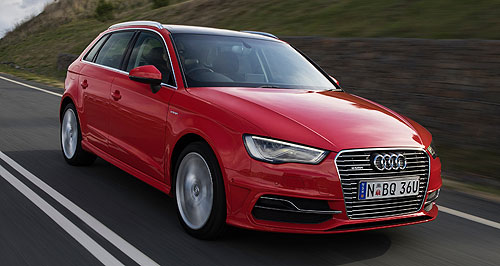Audi’s A3 e-tron hits the showroom floor
BY TIM ROBSON | 9th Jul 2015

The pricing undercuts the range extender version of rival BMW's i3 hatch that starts from $69,900, and it takes its place at the top of the A3 Sportback range above the sporty $61,100 S3.
This is likely to change with the arrival of the hardcore RS3 by the end of this year.
Some 40 orders are already in the books for the e-tron, according to Audi Australia senior product communications executive Shaun Cleary, and customers will receive their new cars in the coming weeks.
“Production started quite slowly for the e-tron, hence the slight delay,” said Mr Cleary. “It’s entirely new technology for Audi in a production sense, and it’s being incorporated into the same production line in Ingolstadt and the regular A3.
Mr Cleary also said that the company hoped to sell ten A3 e-trons a month.
The A3 e-tron, previewed locally last year at an event in Hamilton Island and at a pre-event launch in November last year, marks the first commercially available plug-in hybrid from Audi.
“The A3 Sportback e-tron is the first plug-in hybrid vehicle from Audi, and importantly, it gives our customers an innovative and extraordinarily efficient mobility solution, without compromising on any of the versatility that has made the new A3 Sportback such a success,” said Audi Australia managing director Andrew Doyle.
The company has embraced electric/fossil fuel technology on the race track, but its progress in the real world has been more stop/start. A long-promised R8 e-tron was announced, cancelled, then revived, while an A1 e-tron was displayed at the 2010 Geneva motor show, but has gone no further.
Audi joins BMW (i3) and Mitsubishi (Outlander PHEV) in offering a relatively affordable plug-in hybrid in the Australian market, after the demise of the Holden Volt. Mercedes-Benz will soon join the throng with a C350, while more expensive PHEVs from Volvo (XC90) and BMW (X5) will launch in 2016.
The A3 e-tron is a front-wheel-drive plug-in hybrid that uses a combination of a 110kW, 1.4-litre four-cylinder turbocharged petrol engine and a 75kW electric motor nestled beside it. Combined output is rated at 150kW and 350Nm of torque, and claimed fuel economy is 1.6 litres per 100 kilometres, with just 37 grams of CO2 emitted per kilometre.
The five-door Sportback can be driven in pure EV mode for a distance of up to 50km, while its maximum theoretical range using both petrol and electric engines combined is 920km.
Audi says the A3 can accelerate to 100km/h in 7.6 seconds, and can top 222km/h, while its EV mode top speed is 130km/h. A revised six-speed automatic transmission is the only one offered.
Charging of the 8.8kWh battery can be done from a standard household 10amp plug, and will take five hours to charge fully, according to Audi.
A fast charger system will be offered to A3 e-tron customers, comprising of a dedicated single-phase 230v/16amp circuit that can reduce charging times to just 2.5 hours.
The system will be in most cases included in the purchase price of the car, subject to an inspection of the installation site.
Owners can also take advantage of a partnership between Audi Australia and Origin Energy to purchase renewable energy displacement credits, as part of the energy company’s GreenPower program.
A certificate stating that the first 10,000km of grid-based charging has been offset by renewable energy displacements will be issued to any owner who joins the scheme.
It comes standard with Audi’s Drive Select system, which allows the driver to select from various modes including Comfort and Eco. A rearview camera with front and rear sensors, LED headlights and daytime running lights, keyless entry, leather interior trim and steering wheel, an MMI infotainment system that includes satellite navigation, Bluetooth streaming, DVD and DAB+ digital radio are also standard.
The battery array is installed behind the rear seats, necessitating a relocation of the fuel tank to underneath the boot floor. This reduces the A3 e-tron’s boot capacity to 280 litres – a loss of 100 litres over the regular car. The space expands to 1120 litres with the seats folded flat.
The fuel tank is smaller, as well down from 55 litres to 40 litres.
The Australasian New Car Assessment Program has rated the e-tron at five stars, thanks to the rating awarded to its siblings in the A3 range. It comes standard with seven airbags.